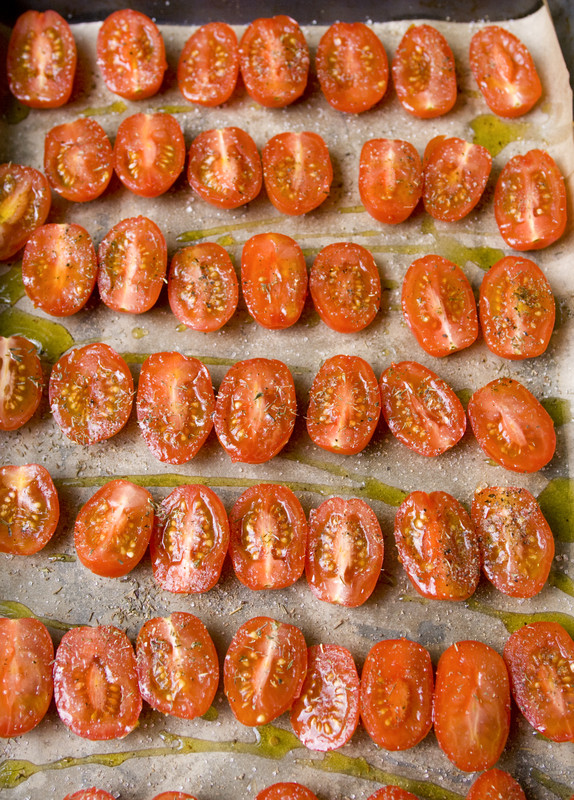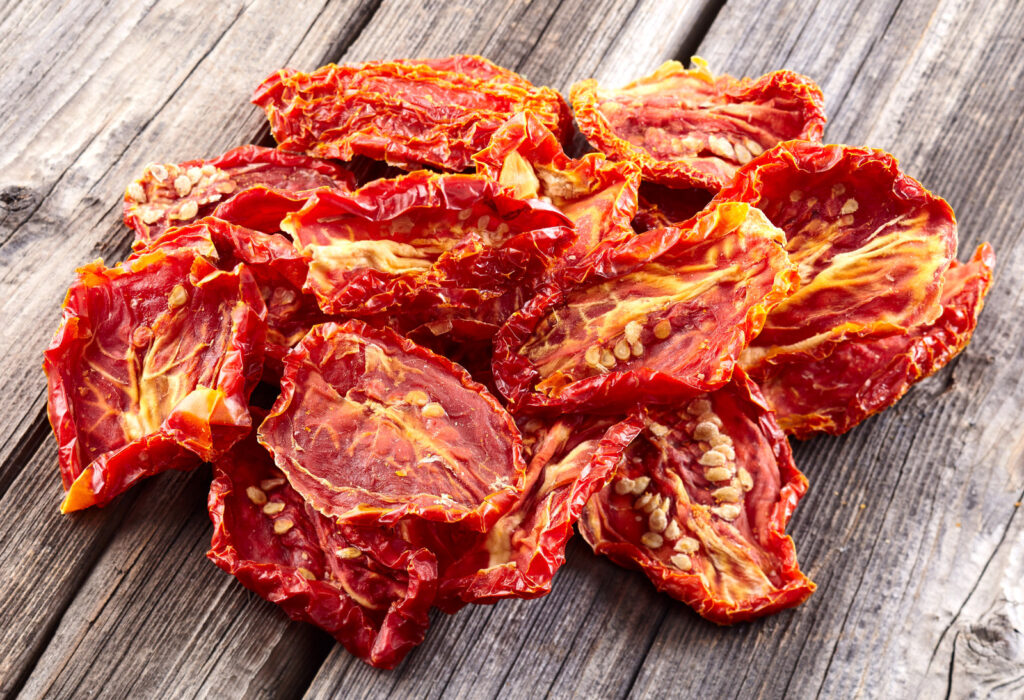Sun-dry tomatoes or oven-dry tomatoes to use for seasoning in salads, soups, stews, casseroles, mixed vegetables, and snacks. You can also rehydrate dried tomatoes for use in cooking.
Dried tomatoes are fresh, ripe tomatoes that have been placed in the sun, in an oven, or in a food dryer to dry out the water content. A dried tomato has every bit of the nutritional content—high in Lycopene, antioxidants, and vitamin C–of fresh tomato and the taste.
The idea of drying tomatoes came from Italy where the process was used to store tomatoes into the winter. Tomatoes were placed on tile roofs and sun-dried in the heat of the summer. Today, some tomatoes are still sun-dried—usually on large outdoor racks; most are dried in convection ovens or large food dryers.

Best tomatoes for drying
Not all tomatoes are perfect for drying. The best tomatoes for drying have thick, meaty flesh and low water content. Choose firm, ripe, full-flavored tomatoes that are heavy for their size. Tomatoes with a high acid content dry best. Excellent tomato varieties for drying are San Marzano and Principe—both flavor favorites dried, and also Roma, Viva Italia, and Early Girl. Beefsteak tomatoes are not a good choice for drying; they are fat, juicy, and full of seeds. The Early Girl is a smaller, fleshy tomato with as few as 24 seeds plus a great flavor.
Tomatoes for drying are usually split lengthwise or quartered, the seeds are removed—though as much as possible of the pulp in the center is left. They are sometimes sprinkled with salt or herbs—but not always–then placed on racks or in a dryer and dried. It will take two to three days for tomatoes drying under a hot summer sun to become completely dry. Twenty pounds of fresh, ripe tomatoes will dry down to about one pound of dried tomatoes.
Dried tomatoes can be served in any dish where you would serve fresh tomatoes.
Kitchen Helpers from Amazon:
- Oster Vegetable Steamer
- Chef’s Knives Set of 6
- EZ Off Jar Opener for Weak Hands
- Pepper Core Remover Stainless Steel
- Kitchen Utensils – Set of 35
Preparing tomatoes for drying
Prep: Wash tomatoes then blanch for best flavor and color after drying. Blanching inactivates enzymes and makes for better storage.
Blanch tomatoes in hot water or steam: Blanching can prevent dried tomatoes from turning black from oxidation—but may lessen flavor.
- Hot water blanching: Place just enough water in a pot to cover the tomatoes. Bring water to a boil then place the tomatoes in the pot for 1 to 2 minutes. Keep the lid on the container when blanching. Cool the tomatoes immediately under cold water.
- Steam blanching: Add 1½ to 2 inches of water to the pot and heat to boiling. Place colander into pot with tomatoes, cover, and steam until heated through, about 2 to 3 minutes. After steaming, tomatoes should look translucent when sliced to the center. Cool the tomatoes immediately under cold water.
Slicing: Once blanched, cut out the cores and peel (but you don’t have to) then cut into slices about ⅛ to ½ inch thick with a sharp knife to avoid crushing the tissue. Cut small pear or plum tomatoes in half. Drying trays. Distribute the slices evenly on drying screens or oven trays in a single layer.

How to dry tomatoes
Sun-drying tomatoes outdoors
Spread tomato slices out on a piece of screen (and set the screen up on wooden blocks so there is plenty of air circulation). Set the tomatoes in the sun and cover them with a cheesecloth tent so bugs and dust cannot get at them. Sun-dry tomatoes until they are brittle; this will take one or two days. Drying tomatoes in 100°F heat with little humidity is ideal. If temperatures cool at night or humidity is high bring drying tomatoes in for the night then set them back outside the next day.
Drying tomatoes in a conventional oven
Spread tomatoes out on oven trays and dry them at 120°F for 18 to 24 hours or until they are crisp. Leave the oven door open about 4 inches and place a fan nearby to circulate air through the oven. Turn the slices and rotate the tray once or twice to prevent scorching. An accurate oven thermometer placed on the tray near the back of the oven will ensure the proper temperature is maintained. The temperature may vary (because the oven door is open) between 120°F and 140°F—just make sure the tomatoes at the back of the oven don’t burn. You can place multiple trays in the oven; two to four trays should hold four to six pounds of tomatoes.
Drying tomatoes in a food dehydrator
Dry tomatoes at 120°F for 8 to 10 hours then turn the slices over and dry them for another 6 to 8 hours or until they are crisp.
Packaging and storing dried tomatoes
Pack dried tomatoes after they have completely cooled. Wait 5 to 7 days to pack sun-dried tomatoes allowing the fruit to redistribute excess moisture. Package tomatoes securely in plastic bags, rigid plastic containers, or glass jars. Seal or cover the bags or containers tightly excluding most excess air (air and moisture are easily reabsorbed into the fruit shortening storage life). If you are worried that insects might have touched tomatoes while sun-drying, place the bags or containers in the freezer for 48 hours or more to kill insects and eggs.
Label each container with the variety and the harvest and drying dates.
Dried tomatoes can be stored in a dry, cool, dark place for 6 to 12 months. The cooler the storage place the longer the shelf life.
Rehydrating dried tomatoes
To rehydrate and use dried tomatoes, cover with boiling water or vegetable stock and let them stand for 20 to 30 minutes, stirring occasionally until they have absorbed most of the liquid. Add more liquid if the tomatoes absorb the liquid and still look shriveled. You can then cook as you would fresh tomatoes.
You can also chop dried tomatoes in a blender for seasoning in salads, soups, stews, and mixed vegetables. Dried tomatoes do not rehydrate well for use in salads.
Related articles:
How to Harvest and Store Tomatoes
Nine Ways to Cook and Serve Tomatoes
Garden Planning Books at Amazon:
- Vegetable Garden Almanac & Planner
- Kitchen Garden Grower’s Guide Vegetable Encyclopedia
- Vegetable Garden Grower’s Guide
- Tomato Grower’s Answer Book
Tomato articles at Harvest to Table:
How to Plant and Grow Tomatoes
How to Choose a Tomato for Your Garden
Growing Tomatoes in Containers
Growing Early Season Tomatoes for Great Taste
Epsom Salt, Milk, and Organic Fertilizers for Tomatoes and Peppers
How to Prevent Blossom Drop – Tomatoes and Peppers
How to Harvest and Store Tomatoes
Nine Ways to Cook and Serve Tomatoes
Tomato Sauce–Basic, Herbed, or Vegetables Added
How to Make Tomato Juice Simply
How to Home Can Tomatoes for Beginners
How to Sun Dry and Oven Dry Tomatoes
Tomato Growing Problems Troubleshooting
How to Prevent Tomato Blossom Drop
How to Identify Early Blight, Late Blight, and Leaf Spot
Tomato Hornworm Organic Pest Control















